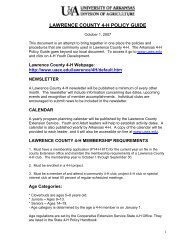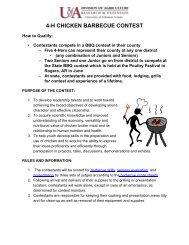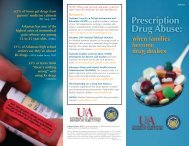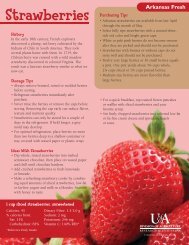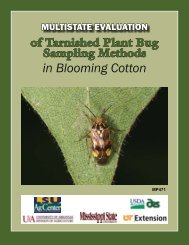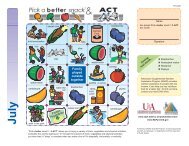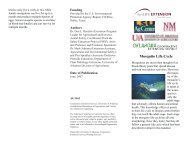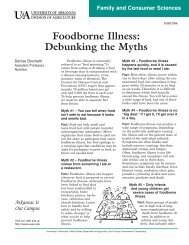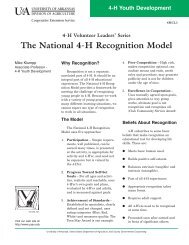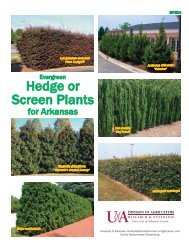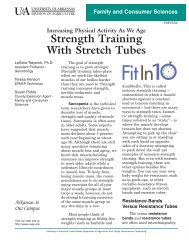Establishing Seeded Bermudagrass on Lawns, Golf Courses or ...
Establishing Seeded Bermudagrass on Lawns, Golf Courses or ...
Establishing Seeded Bermudagrass on Lawns, Golf Courses or ...
You also want an ePaper? Increase the reach of your titles
YUMPU automatically turns print PDFs into web optimized ePapers that Google loves.
Although low seeding rates may increase stol<strong>on</strong><br />
growth, winter survival of seeded bermudagrass<br />
has not been measurably affected by seeding rate<br />
(15,18). Higher seeding rates can produce higher<br />
initial tiller and seedling densities, but bermudagrass<br />
establishment is not enhanced sh<strong>or</strong>tly after seeding<br />
Fig. 1. Hulled ʻRivieraʼ bermudagrass (2,900,000<br />
seeds/lb).<br />
by seeding rates greater than 1.0 lb PLS/1,000 ft 2 (18).<br />
Based <strong>on</strong> research, a seeding rate of 0.5 to 1.0 lb<br />
PLS/1,000 ft 2 is recommended in most situati<strong>on</strong>s.<br />
Although the number of seeds per pound differs<br />
by cultivar and coating (hulled vs. unhulled vs.<br />
coated) (Figs. 1 and 2), there is typically no distincti<strong>on</strong><br />
made when recommending a seeding rate. Many<br />
improved bermudagrass cultivars, such as Riviera<br />
and Yuk<strong>on</strong>, are sold with a seed coating c<strong>on</strong>taining<br />
fertilizer, fungicide <strong>or</strong> other products to improve<br />
handling, germinati<strong>on</strong> and establishment (Fig. 3).<br />
This coating decreases the number of pure live seeds<br />
per pound by dramatically lowering purity; theref<strong>or</strong>e,<br />
seeding costs increase because higher seeding rates<br />
are needed. By definiti<strong>on</strong>, pure live seed is determined<br />
by multiplying the germinati<strong>on</strong> percentage by<br />
the percent purity of the seed lot. The weight of seed<br />
required to supply 1.0 lb of PLS is approxi mately<br />
1.09 lb with uncoated seed and approximately 2.32 lb<br />
of coated seed.<br />
Post-Seeding Weed C<strong>on</strong>trol<br />
Weed c<strong>on</strong>trol is imp<strong>or</strong>tant when seeding<br />
bermudagrass in n<strong>on</strong>fumigated soil because the optimum<br />
seeding period coincides with the germinati<strong>on</strong><br />
of summer grassy and broadleaf weeds. Grassy and<br />
broadleaf weeds compete f<strong>or</strong> resources and reduce<br />
seeded bermudagrass establishment if they are not<br />
completely c<strong>on</strong>trolled bef<strong>or</strong>e renovati<strong>on</strong> <strong>or</strong> after<br />
seeding. Though weed species and pressure vary<br />
am<strong>on</strong>g sites, weeds that comm<strong>on</strong>ly reduce bermudagrass<br />
establishment in the transiti<strong>on</strong> z<strong>on</strong>e include<br />
crabgrass, goosegrass and sedges.<br />
Fig. 2. Unhulled ʻRivieraʼ bermudagrass (1,700,000<br />
seeds/lb).<br />
Fig. 3. Coated ʻRivieraʼ bermudagrass (725,000 seeds/lb).<br />
Many herbicides are labeled f<strong>or</strong> weed c<strong>on</strong>trol<br />
in established bermudagrass, but as of spring 2009,<br />
<strong>on</strong>ly Quicksilver (carfentraz<strong>on</strong>e) and Drive (quin <br />
cl<strong>or</strong>ac) are labeled f<strong>or</strong> use <strong>on</strong> bermudagrass seed <br />
lings. Despite the lack of products labeled f<strong>or</strong> use in<br />
bermudagrass seedlings, many products have been<br />
screened f<strong>or</strong> their safety. Herbicide applicati<strong>on</strong>s are<br />
often based <strong>on</strong> the date emergence occurs <strong>or</strong> <strong>on</strong> plant<br />
age. Emergence is defined as a unif<strong>or</strong>m stand of <strong>on</strong>eleaf<br />
seedlings about 0.5 inch tall, <strong>or</strong> where 75% of<br />
seedlings had emerged. Germinati<strong>on</strong> typically occurs<br />
7 to 10 days after seeding under optimum c<strong>on</strong>diti<strong>on</strong>s<br />
(Fig. 4). Emergence occurs <strong>on</strong>ce the maj<strong>or</strong>ity of the<br />
stand has germinated and begun to develop.<br />
Although emergence typically occurs after germinati<strong>on</strong><br />
approximately 14 days after seeding under<br />
optimum c<strong>on</strong>diti<strong>on</strong>s, emergence can occur later if<br />
bermudagrass is d<strong>or</strong>mant seeded, seeded when soil<br />
and air temperatures are cool <strong>or</strong> when soil moisture<br />
6





